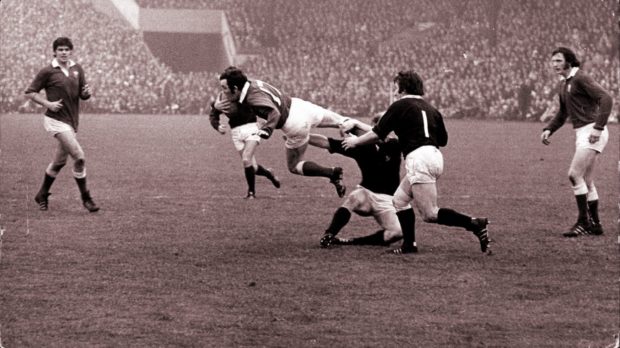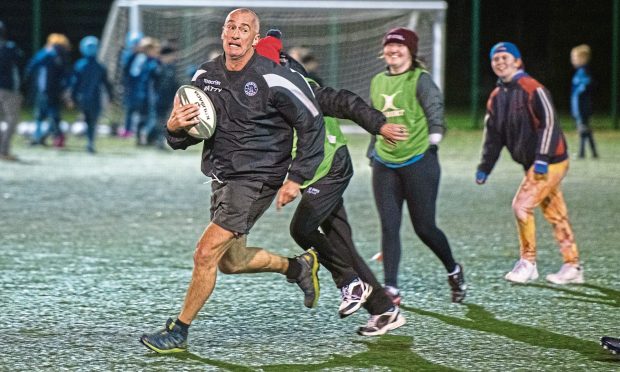You wouldn’t get a picture like this from 21st century rugby, more’s the pity.
It’s a lineout (I think), and the ball has been thrown to the tail (possibly) where England’s Andy Ripley, a dashing figure in the 1970s with his long hair, seems set to gather. Only Peter Brown, captain of Scotland, is reaching around the English No 8 with his left hand in an attempt to steal or at least disrupt possession.
Left and right of this is, well, utter chaos. England’s legendary flanker Tony Neary has someone in a headlock. Ian McLaughlan, the great Mighty Mouse, and towering lock Alastair McHarg are wrestling with whoever is standing next to them.
Only Sandy Carmichael, McLaughlan’s propping partner for Scotland and the Lions, stands far left as an unengaged observer in a mess of fifteen torsos and 30 flailing limbs. It’s as far removed from the slickness of a modern rugby setpiece as is imaginable.
The picture is from a rare game indeed – Scotland’s fourth successive win over England, at Murrayfield in 1972. Thanks to our historically desperate record at Twickenham, that was a new record that stands untouched to this day.
But it’s how CLOSE the photographer is that is startling. Given the modern SRU’s high-handed and overbearing attitude to the media, a modern snapper couldn’t get nearly as intimate with the game and the players, even with modern equipment.
This photograph is among hundreds contained in a evocative new book Dark Blue Blood: Scottish Rugby in the Black & White Era, compiled by Steve Finan and published next week by DCT Media.
It’s a compilation of rare treasures found within the DC Thomson photo archives dating from the 1870s to the 1980s, with a foreword from the latter era’s hero and legend, Doddie Weir.
Many of these photographs haven’t been seen since they appeared in print in The Courier, the Sunday Post or other newspapers and magazines.
A few appear to be damaged or doctored, but this is not by modern computer trickery, but by chinagraph pencil and clumsy cropping, as editors tried to make them fit the space with the basic methods they had at the time.
Steve makes no apology for leaving the pictures as they were.
“I do not use Photoshop to correct, clone in, or adulterate the photos, no matter how old, damaged and battered they are,” he says.
“I reckon the photos have had long working lives for newspapers and magazines, and their condition reflects that. They are authentic.”
The international game and Scotland’s battles with the Auld Enemy feature prominently, of course. There’s the first Scotland team for rugby’s first international at Raeburn Place in 1871, 20-a-side, 14 of whom were forwards, so the chaos was probably far worse even than 1972. Scotland won that day by a goal and a try to a try. As in the other football code, Scotland were pretty decent at rugby in the late 1800s.
The immortals of 1925, Scotland’s first Grand Slam team, are also featured. On the far right of the team photograph is a slight looking figure, arms crossed rather awkwardly, looking almost embarrassed.
It’s Ian Smith, the legendary Flying Scotsman, whose 24 tries in internationals was a record that stood for nearly 60 years until David Campese broke it in the mid-1980s. Brian O’Driscoll only passed Smith’s Five/Six Nations record in 2011, and he remains Scotland’s joint top try scorer, fifty years after his death.
There are scores of evocative shots from Murrayfield over the 1950s – a barren decade – the 1960s and 70s all the way up to the Grand Slam of 1984. Particularly striking is an action shot of the recently and sadly departed Dougie Morgan, belting over a penalty in the 1975 12-10 victory over the legendary Welsh team of that decade.
Included in the panorama shot – again, the snapper seems to have got incredibly close to Morgan – are his team mates lined across the pitch including the great David Leslie, Jim Renwick, Gordon Brown and McLaughlan, and the vast expanse of humanity crammed on Murrayfield’s Eastern Terrace in what was, at the time, a world record crowd of 104,000.
But there are plenty of treasures away from the international game in Dark Blue Blood, from the heartlands of the Scottish game.
There’s the All Blacks finishing their haka with the old, traditional leap (now defunct for fear of pre-match strained muscles) somewhat incongruously in front of the King Street multi-storeys in Aberdeen, before they played the North and Midlands at the old Linksfield Stadium in the late 1970s.
There’s beautiful shots of the Hawick, Melrose and Langholm sevens, all packed to the gunnels with people in macs and scarves.
And club teams: both Hawick with the great loosehead Hughie McLeod and Howe of Fife with Dave Rollo who propped on the tighthead in the same era. Both legends finished with 40 caps when only four or five international games were played a year.
And there are teams from not only the leading sides of the day but the local sides of the day – Panmure, Morgan, Dundee HSFP, Kirkcaldy, Harris and others, all snapped at the outset of the season for The Courier’s rugby columns of the 1960s and 70s.


